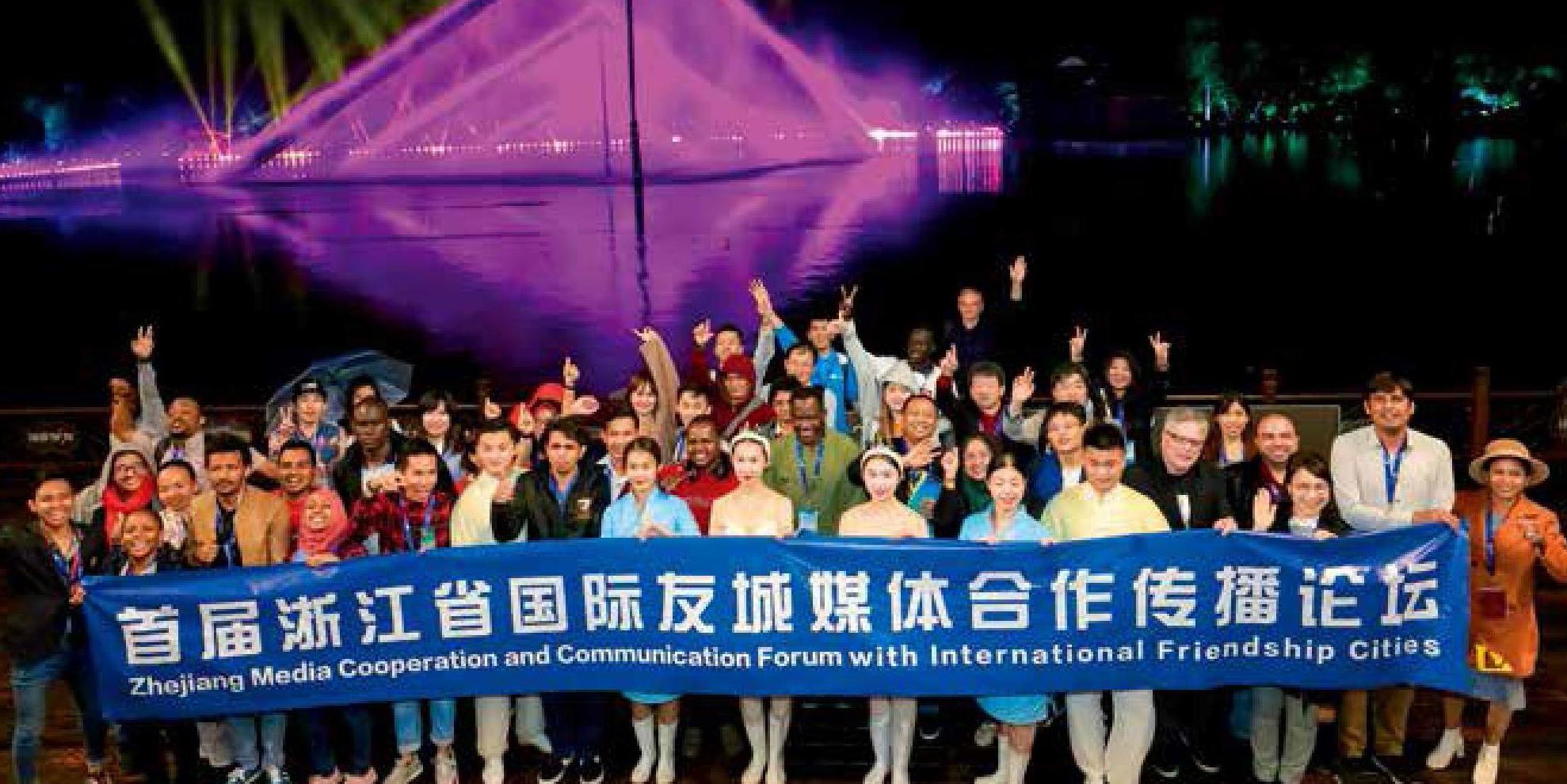从丝绸到黄酒 品味诗意与绵柔
2019-12-13叶珂
叶珂

海外友城媒体协会代表分成A、B两队,近距离体验了浙江的秀美山水和经济社会发展,彼此之间就媒体发展、国际合作和文化交流交换了意见和看法。
参加B线采风活动的嘉宾先后走访了杭州、金华和绍兴等地,参观了杭州中国丝绸博物馆、义乌国际商贸城、浦江嵩溪村、绍兴兰亭和黄酒博物馆、杭州梦想小镇等有浙江特色的地方,领略了不一样的浙江风情。
他们的观感基本一致:浙江不仅是一个美丽华贵且富含文化气息的中国省份,更是一处代表中国未来经济社会发展方向的创新高地。
一杯花雕 醉入江南
从中国丝绸博物馆、兰亭书法博物馆,再到中国黄酒博物馆,嘉宾们通过参观、体验和现场互动,近距离感受了中国江南文化的独特魅力,加深了对浙江和江南文化的理解。
众所周知,长三角地区是中国经济最具活力、开放程度最高的区域之一,是“一带一路”与长江经济带的重要交汇地带,同时也是国际社会了解中国经济社会发展的重要窗口。这一地区独具特色的发展模式离不开当地江南文化的滋养。江南文化推崇“重商崇文”“开放包容”和“理性务实”,其特有的文化传统和精神范式,深刻地影响着长三角地区城市群的发展和变化,成为这一地区经济社会发展背后的强大推动力。作为江南文化的重要发祥地之一,浙江有着丰厚的人文底蕴,也是江南文化独具代表性的一个分支。此次的媒体采风,对于各国媒体代表们来说,也是一次独特的中国江南文化的体验之旅。
在采风活动的第三天,B线的媒体代表团抵达浙江绍兴,先后参观了书法圣地——兰亭的书法博物馆,以及代表中国黄酒文化的著名景点——中国黄酒博物馆。那天刚好下起了蒙蒙细雨,但这丝毫没有影响媒体代表们的热情。在兰亭书法博物馆著名景点“曲水流觞”处,伴随着清溪潺潺流水声,媒体代表们纷纷穿戴上晋朝服饰,尝试品酒、赋诗,效仿中国古人,再现“群贤毕至,少长咸集”的曲水流觞场景。
绍兴的黄酒之美,不仅仅体现在味道上,也直观地体现于外在,例如精美、艺术价值不低于收藏品的花雕酒坛。随后,在参观中国黄酒博物馆时,代表们亲自体验了一把花雕酒坛脸谱DIY的绘制。
经过一个多小时的努力,兴奋不已的嘉宾根据自己的喜好绘制而成的脸谱涂鸦先后出炉。一位来自马来西亚的记者表示,这是他第一次尝试这样的绘画,感到十分开心,并认为这是他人生中一次难忘的“花雕之旅”。
几年不见 不识义乌
从鸡毛换糖到全球电商,义乌的发展是中国融入世界的一个缩影。此次行程中的义乌国际商贸城,见证了浙江特别是义乌的发展和变迁,是此行媒体嘉宾们最为感兴趣的采访点之一。在这座久负盛名的小商品城,每天有超过10万吨的商品在进行交易,贸易的触角更是延伸到了世界200多个国家和地区。在琳琅满目的商铺前,嘉宾们纷纷驻足,一边拿出手机拍照,一边与店家交谈,了解商贸城和义乌的近况。
除了惊讶于义乌国际商贸城的规模和发展速度,一些媒体代表还对部分售卖中国网红商品的店铺产生了浓厚的兴趣。在一家售卖网红饮料杯的店铺前,来自非洲和埃及的两位记者兴致盎然地拿起杯子,时不时地询问店家杯子的使用方法。他们表示,类似的产品在他们国家并不多见,希望以后有机会还能再来义乌逛一逛。
来自布基纳法索《希德瓦亚报》的Badolo Karim说,早些年他曾来过义乌一次,当时是为了采访在义乌从商的布基纳法索商人,这座新兴的充满活力的城市给Badolo Karim留下了很好的印象。同时他也很看好中国与非洲国家的贸易前景,希望未来两地区能有更多的商贸交流。据统计,目前有来自非洲50多个国家和地区的3000多名常驻外商在义乌,每年入境的非洲客商达8万多人次。
除了义乌国际商贸城,以梦想小镇和吉利汽车等为代表的一批浙江高科技企业、先进制造业标杆企业,也给嘉宾们留下了深刻的印象。来自日本静冈县第一电视台的增田谦表示,浙江高科技产业的发展速度让他心生敬佩,他希望能与更多的浙江媒体一起,共同开展基于高科技领域的新闻报道,共同关注两地经济社会的发展和变化。
一块麻糍 回到家乡
在此次采风行动中,有一站令所有媒体嘉宾们都赞叹不已,很多人更是流连忘返,这便是浙江著名的“千年古村落”——金华市浦江县的嵩溪村。作为浙中地区保存最完善、体量最大的古村落,嵩溪村距今已有千年以上的历史,村内保存着庞大的古建筑群,其建筑多为清代遗存。增田谦表示,嵩溪村的体验让他切身感受到了浙江文化的独特魅力。在他看来,这是一种很特别的体验。
在当地村民和干部的热情招待之下,代表团的成员们近距离感受了一次嵩溪村当地的民俗活动,品尝了各种特色美食。在民俗活动体验环节,来自巴基斯坦、非洲等地区的媒体代表们兴致盎然地体验了打麻糍。不少非洲伙伴表示,麻糍和非洲当地的一种特色主食Fufu类似,也是由淀粉和水混合制作而成,这让他们倍感亲切,仿佛回到了家乡。
在当地一个酒肆的一块空地前,嘉宾在酒肆主人的盛情款待之下,还伴着音乐跳起了舞蹈。那一刻,仿佛各种文化差异和沟通障碍都消失了,彌漫在空气里的是浓烈的文化融合的味道。
当得知浙江在助推乡村振兴和非物质文化遗产保护方面采用了乡村旅游这一发展模式时,来自马来西亚《星洲日报》的一位记者由衷地发出感叹,认为浙江的这一做法非常具有创新性,可以为其他国家的非物质文化遗产保护和乡村振兴提供借鉴思路。她谈到,非物质文化遗产保护是各国都普遍关心的议题,但要真正做好其实不那么容易。浙江的做法非常睿智,提供了一种可持续发展的保护思路。
对于远道而来的外籍客人,嵩溪村当地的村民和干部表达了自己的热情。不少村民纷纷拿起手机和嘉宾们合影,一些不擅长用英语沟通的村民以肢体语言与嘉宾们交流,其好客之情,溢于言表。
为期3天的媒体采风活动在《印象西湖》的唯美演出中落下了帷幕。通过体验、行走和对话,不同文化背景的媒体专业人士从多个角度再一次认识了浙江,近距离感受了浙江在自然、人文和经济社会等各方面的魅力。
Divided into two groups, the participating media representatives of the first Zhejiang Media Cooperation and Communication Forum with International Friendship Cities, took part in a post-forum “cultural tour”, an eye-opening experience that covered the most culturally distinctive places and various sites highlighting the industrial innovation in Zhejiang Province. At the end of the tour, the consensus that Zhejiang is not only a scenic and cultural destination worth visiting but also a highland of economic innovation was reached.
The unique “Jiangnan” charm of Zhejiang, highlighted by a dozen cultural spots such as China Silk Museum in Hangzhou, the Orchid Pavilion Calligraphy Museum and China Rice Wine Museum in Shaoxing, is better appreciated first-hand, as testified by every participant in Group B.
It is widely known that the Yangtze River Delta region is one of Chinas most dynamic economies, a conduit connecting “Belt-and-Road” practices with the Yangtze River Economic Belt, and an important window for the international audience to follow the updates of Chinas social and economic scene. The regional development features of the Yangtze River Delta are fostered partly by the unique culture of “Jiangnan”. Behind the regions GDP miracles is the interaction of the qualities forged by what can be summarized as the “Zhejiang mentality” that is deeply rooted in rich cultural heritage and powered by open-mindedness and a down-to-earth attitude of Zhejiang people.
Day 3 of the tour of Group B brought the delegation to Shaoxing, Chinas “Calligraphy Holy Land” that hosts a good many interesting cultural sites represented by the Orchid Pavilion and China Rice Wine Museum. At the Calligraphy Museum, participants gathered along the coursing stream and relived the joy of 42 tipsy literati gentlemen engaging in a drinking contest on a fine, late spring day in 353 and producing the most well-known calligraphic masterpiece. At the rice wine museum, the participants took part in various hands-on activities such as decorating wine jars.
The rise of Yiwu and its small commodities market is a vignette of Chinas integration into the world market. The visit to Yiwu, where the Yiwu International Trade City is based, was the most exciting highlight of the tour. Everyone in the delegation enjoyed every minute of photographing and perusing the booths that are selling a dazzling variety of goods to more than 200 countries and regions.
Badolo Karim, from a newspaper in Burkina Faso, visited Yiwu years ago to interview some businesspeople here, and was impressed by the vibrant town. He is optimistic about the future of the trade relation between China and Africa. Statistics show more than 3,000 businesspeople from over African 50 countries and regions are doing business in Yiwu, and the city receives about 80,000 visitors from Africa every year.
The delegation also visited Alibaba and Jeely Auto Group, both based in Hangzhou. The guests were deeply impressed by the provinces high tech and manufacturing sectors. “I cant help but admire the fast development of the high-tech industry of Zhejiang Province, and I am looking forward to working more closely with my counterparts in Zhejiang to make the provinces amazing high-tech achievements known by more people in Japan,” comments a journalist from Shizuoka TV.
Another highlight of the tour was a visit to Songxi Village in Pujiang County, Jinhua in central Zhejiang. The cultural immersion in this ancient village that boasts a history of more than 1,000 years and a great number of well-conserved Qing architectural houses opened the eyes of everyone in the group. In fact, Songxi represents the large number of ancient buildings in central Zhejiang. “It was quite an experience in which I came to understand the unique culture of Zhejiang in a different way and through more dimensions,” says the Japanese journalist from Shizuoka TV.
The participants took part in many cultural activities specially designed for foreign journalists to engage in the local social habits such as food culture. Making “maci” (glutinous rice cake) with the villagers brought several members of the delegation back to their hometown in Africa, where a local staple food item they call “Fufu” tastes much like “maci”; and the hospitality of the owner of a local tavern filled the heart of everyone with warmth, as if the distance caused by cultural difference and language barriers disappeared and was transformed into harmony and joy.
For one journalist from Malaysias Sin Chew Daily, the pioneering practice of realizing rural revitalization and cultural heritage protection through the development of rural tourism is inspiring. “It is a strategy that successfully takes sustainability into consideration when it comes to the protection of cultural heritages,” she points out.
Throughout the three-day exploration in Zhejiang, body language proved to be an effective solution when the language barrier got in the way. The delegation enjoyed a truly cultural and artsy ending in a dreamlike night of , a grand show on the West Lake that debuted for state leaders attending the G20 Summit Hangzhou in September 2016. It is believed that the end of the tour will usher in a brand new start in the cultural dialogue and mutual understanding between Zhejiang and the world.
